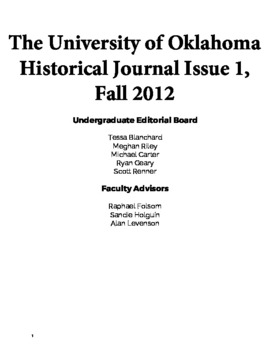| dc.contributor.editor | Blanchard, Tessa | en_US |
| dc.contributor.editor | Riley, Meghan | en_US |
| dc.contributor.editor | Carter, Michael | en_US |
| dc.contributor.editor | Geary, Ryan | en_US |
| dc.contributor.editor | Renner, Scott | en_US |
| dc.date.accessioned | 2016-11-15T21:57:42Z | |
| dc.date.accessioned | 2021-04-14T15:12:24Z | |
| dc.date.available | 2016-11-15T21:57:42Z | |
| dc.date.available | 2021-04-14T15:12:24Z | |
| dc.date.issued | 2012-10-01 | en_US |
| dc.identifier.uri | https://hdl.handle.net/11244.46/1247 | |
| dc.description | A note on the selection of these papers: Because our student editors are among the best students we have, the faculty advisors of the journal asked them to submit their papers under pseudonyms, such that the editorial board as a whole could consider their work in an unbiased way. Each of the 39 submissions to the journal was first read by two editors, who ranked them one to ten. A number one vote was assigned ten points, and a number ten vote was assigned one point. The points were then aggregated, and the top ten vote-getters were then read by all members of the editorial board, who ranked them 1-10. The points were then aggregated once again, giving us one winner, five runners up, and two honorable mentions. Normally, the Griswold Prize winner would receive $300, and the runners-up would receive $100 each. But in order to avoid giving the impression of self-dealing, we agreed ahead of time that if an editorial board member won a prize, his or her prize money would be divided among the other prize winners. Since Meghan Riley, who submitted her work under the name Elizabeth Count, ended up winning the Griswold Prize, her winnings were divided among the five runners-up, who have each been awarded $160. | en_US |
| dc.description.abstract | Preface to the Inaugural Issue of the OU Historical Journal by Raphael B. Folsom, Assistant Professor of History | en_US |
| dc.description.abstract | Every year, students at the University of Oklahoma write hundreds of papers for their courses in the History Department. These range from short journal entries and in-class writing exercises to critical review essays and long research papers. Of those written works, roughly a quarter get A's. Of those A's, a smaller proportion are forwarded to the editorial board of the OU Historical Journal. Of the dozens of papers the editors receive, only six are chosen to be published. And only one receives our annual prize for excellence. | en_US |
| dc.description.abstract | The papers we publish in the first issue of the OU Historical Journal are thus the product of an enormous amount of intellectual work: the work of the administrators who coordinate the many courses offered in the history department, the work of our faculty members, who devote passion and precision to teaching the subjects they love, and most importantly, the work of our undergraduates, who struggle, strive, and sometimes triumph in the rigorous discipline of historical scholarship. This journal is a tribute to the extraordinary daily efforts of all the above, and a testimony to the kinds of achievement that their collective labors make possible. | en_US |
| dc.description.abstract | A few words are in order about our editorial board. Our five undergraduate editors were nominated by faculty members who had taught them, and voted on by the history faculty as a whole. Their election to the editorial board recognizes their excellence in a broad variety of history courses at OU. It marks their transition from being students in our department to being among its intellectual leaders. Tessa Blanchard, Meghan Riley, Michael Carter, Ryan Geary, and Scott Renner deserve high praise for the hard work they applied to the tasks of conceiving and promoting the journal, collecting submissions, and selecting works for publication. | en_US |
| dc.description.abstract | The criteria we used for the selection of these papers were the same ones the department employs in the senior capstone course. Developed by Professor Melissa Stockdale, and approved by the faculty as a whole, these criteria can be found here. In publishing them, we hope to let the university community know about the intellectual values we espouse as a department: hard work, rigorous thinking, distinction in style, and honesty in crediting our sources and scholarly peers. | en_US |
| dc.description.abstract | I speak for many in offering thanks to my fellow faculty advisors, Professor Sandie Holguín and Professor Alan Levenson, for their wit, wise counsel, and hard work. Thanks also to the many professors who shared the secrets of their craft with the students who submitted papers. Thanks especially to the students who took a chance and sent papers to us. It has been a privilege to read your scholarship. And thanks, finally, to the intellectual author of this journal, Dr. Cathy Kelly, and to our department chair, Dr. Robert Griswold. In addition to providing fifteen years of scintillating intellectual leadership to our department, not to mention indispensable support for this journal, Rob has unknowingly lent his name to the inaugural Griswold Prize for Excellence in Undergraduate Historical Scholarship. | en_US |
| dc.relation.ispartofseries | OU historical journal ; 1 (Fall 2012) | en_US |
| dc.title | The University of Oklahoma Historical Journal | en_US |
| dc.contributor.sponsor | Folsom, Raphael | en_US |
| dc.contributor.sponsor | Holguín, Sandie | en_US |
| dc.contributor.sponsor | Levenson, Alan | en_US |
| dc.description.undergraduate | undergraduate | |
